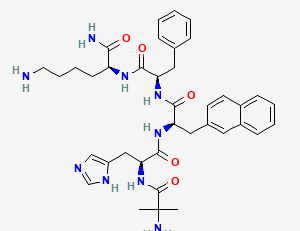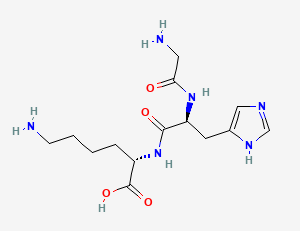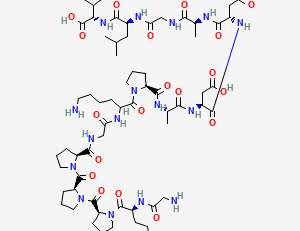The Science of BPC-157 + TB-4
Introduction
Within the expanding field of peptide research, two compounds continue to draw significant scientific attention for their potential roles in cellular repair, angiogenesis, and tissue remodeling: BPC-157 and Thymosin Beta-4 (TB-4), often studied in its synthetic fragment form known as TB-500.


While these peptides originate from naturally occurring sequences found in the body, both remain research compounds, not approved for human use, treatment, or diagnosis. Nonetheless, preclinical research—conducted primarily in rodent and in-vitro models—has yielded intriguing insights into how these peptides may interact with biological systems involved in healing, regeneration, and inflammation control.
This article summarizes the state of scientific research on the combination of BPC-157 and TB-4, explaining what laboratory investigations have discovered, how these two peptides may complement one another in controlled experimental contexts, and what questions remain open for future exploration.
What Are BPC-157 and Thymosin Beta-4?
BPC-157: The “Body Protection Compound”
BPC-157 is a synthetic peptide consisting of 15 amino acids derived from a partial sequence of a naturally occurring protein found in gastric juice known as Body Protection Compound (BPC). It has been studied for its potential roles in angiogenesis, fibroblast migration, and growth factor modulation—processes essential to wound healing and tissue maintenance in laboratory models.

Preclinical studies in rodents have explored BPC-157’s influence on:
- Vascular endothelial growth factor (VEGF) expression
- Fibroblast activity during tissue recovery
- Collagen organization in tendon and ligament models
These findings suggest that BPC-157 acts as a modulator of cellular communication during tissue repair, though its precise mechanisms are still under investigation.(1–3)
Thymosin Beta-4 (TB-4 / TB-500)
Thymosin Beta-4 is a 43-amino acid peptide naturally present in almost all mammalian cells. It is a major G-actin sequestering molecule, meaning it binds to actin monomers and helps regulate cell migration and cytoskeletal remodeling—core processes involved in tissue formation and repair.
Laboratory research has focused on TB-4’s possible roles in:
- Endothelial cell migration
- Angiogenesis (the formation of new blood vessels)
- Cellular differentiation and tissue organization
Because of its influence on actin polymerization, TB-4 has been investigated as a key signaling molecule that helps coordinate the cellular “construction process” following mechanical or biochemical injury in experimental models.(4–6)
Why Study Them Together?
In the laboratory, researchers often investigate synergistic interactions between compounds that act on related pathways. BPC-157 and TB-4 are of interest together because both appear—based on preclinical evidence—to influence cellular migration, blood vessel formation, and extracellular matrix organization, but through different mechanisms.
- BPC-157 is thought to act largely through angiogenic and growth-factor modulation pathways (VEGF, FAK, MAPK/ERK).
- TB-4, in contrast, regulates actin polymerization and cell motility, effectively controlling how cells move and organize during repair.

By combining insights from both, researchers can observe complementary effects in tissue models—BPC-157 providing biochemical “signals” for repair, while TB-4 provides the cellular “mobility and structure” to execute it.
These are conceptual models derived from animal and cell studies, not human data. The combination remains investigational and has not been approved for therapeutic use.(2,4)
Mechanistic Overview: How They Work in Research Models
1. Cellular Migration and Cytoskeletal Dynamics
In wound-healing models, TB-4 has been shown to increase cell motility by regulating the actin cytoskeleton, particularly by sequestering G-actin and facilitating F-actin formation—a process necessary for cells to move into damaged regions.(4,5)
BPC-157, on the other hand, appears to enhance the migration of fibroblasts and endothelial cells by upregulating growth factors that act as chemotactic signals.(1,2)
Together, these actions create a potential synergy: BPC-157 may initiate signaling for repair, while TB-4 enables the cells to physically move and respond to that signal.
2. Angiogenesis and Vascular Support
Both peptides have been investigated for their impact on angiogenesis—the formation of new blood vessels—in animal models.
- TB-4 has been shown to activate vascular endothelial cells and promote tube formation in in-vitro assays.(5,6)
- BPC-157 may enhance VEGF receptor expression and influence endothelial stability during recovery phases in rat tissue studies.(2,3)
In controlled experiments, angiogenesis is a critical step in tissue recovery, as new microvessels provide the nutrients required for cellular growth and remodeling. The combination of TB-4’s endothelial migration effects with BPC-157’s signaling modulation could, hypothetically, accelerate vascular organization—an idea that continues to be explored in research contexts.(1–6)
3. Inflammation and Immune Modulation
Inflammation is a necessary but delicate phase of tissue repair.
- Animal studies suggest BPC-157 may help balance inflammatory cytokine expression, potentially reducing excessive inflammatory signaling while preserving normal immune response.(1,3)
- TB-4 has been observed to affect macrophage differentiation and T-cell migration in preclinical studies.(6)
These findings remain early-stage and exploratory, but they suggest potential cross-talk between immune signaling and cytoskeletal remodeling, two processes essential to organized tissue recovery.
Common Research Questions
Q1. Why are BPC-157 and TB-4 often mentioned together?
Because both have been independently studied in models of tissue injury and recovery, many researchers explore whether combining them in laboratory settings may yield additive or synergistic results. Their mechanisms—signal modulation and cell migration—are biologically complementary, making the pair scientifically interesting to study together.(1–6)
Q2. Has the combination been tested in humans?
To date, there are no FDA-approved human clinical trials on the combined use of BPC-157 and TB-4. Most available data come from animal studies and cell culture research. Any references to “human benefit” would therefore be speculative and not compliant with FDA standards. The compounds remain strictly for research use only.(1–6)
Q3. Are these peptides naturally occurring?
Yes. BPC-157 is derived from a protein fragment found in gastric juice, and Thymosin Beta-4 is produced naturally in nearly all mammalian cells. The versions used in research are synthetic analogs created for controlled study.(1,4)
Q4. Why are they considered “research peptides”?
Because they have not been approved by the FDA for human use, diagnosis, or treatment. They can only be legally sold or used for laboratory research—for example, in cell studies, rodent models, or biochemical pathway mapping.(1–6)
Q5. Are there side effects in research models?
Preclinical studies have generally reported low toxicity and good tolerance in animals, but no compound is without potential biological effects. Since these peptides have not undergone formal human safety evaluations, their risk profile in humans is unknown. That’s why all sales and use must remain within the boundaries of non-clinical laboratory research.(1–6)
Q6. Why do researchers focus on connective tissues, tendons, and ligaments?
These tissues are particularly dependent on angiogenesis, fibroblast migration, and collagen synthesis—all processes where both BPC-157 and TB-4 appear active in animal models. Studying these peptides in tendon or ligament injury models allows researchers to examine how cell movement and growth-factor signaling coordinate during recovery.(2,4–6)
Q7. How are dosing and duration determined in experiments?
Each research setting differs. Typical preclinical studies establish doses based on body-weight scaling and duration of exposure, usually lasting from a few days to several weeks. These parameters are not standardized for human application, as no approved dosing exists outside of research contexts.(1–6)
The Importance of Preclinical Research
The value of preclinical peptide research lies not in producing immediate therapies but in understanding mechanisms. BPC-157 and TB-4 offer researchers insight into:
- How cellular repair signaling can be modulated
- How actin dynamics influence tissue organization
- How angiogenesis and inflammation are intertwined during regeneration
This mechanistic data can inform future pharmaceutical innovation, but additional controlled, peer-reviewed research—including toxicology, pharmacokinetics, and safety profiling—is necessary before any translation to human medicine could occur.(1–6)
What Researchers Are Currently Exploring
Ongoing preclinical investigations include:
- Tendon and Ligament Recovery Models
- Studies using rodent Achilles tendon or medial collateral ligament (MCL) injuries to observe collagen fiber re-alignment and angiogenesis.(2,3)
- Studies using rodent Achilles tendon or medial collateral ligament (MCL) injuries to observe collagen fiber re-alignment and angiogenesis.(2,3)
- Neural Tissue Models
- TB-4 has been evaluated in models of traumatic brain injury for its effects on oligodendrocyte activation and neuronal migration.
- BPC-157 has been examined for potential influence on the gut–brain axis and peripheral nerve recovery, though these findings remain animal-only.(1,4–6)
- Vascular and Cardiac Models
- TB-4 has been associated with cardiomyocyte survival and capillary formation post-injury in mouse models.
- BPC-157 has been investigated for endothelial protection during experimental ischemia.(1,4,5)
- Inflammation and Oxidative Stress
- BPC-157 appears to regulate nitric oxide synthase activity in certain models, while TB-4 influences reactive oxygen species (ROS) pathways in cultured cells.(1,5)
- BPC-157 appears to regulate nitric oxide synthase activity in certain models, while TB-4 influences reactive oxygen species (ROS) pathways in cultured cells.(1,5)
These experimental observations contribute to the understanding of how peptides interact with cellular signaling networks—data that can support the eventual design of safer, targeted therapeutics through formal clinical research channels.
Future Directions
Areas likely to see continued exploration include:
- Systems-biology mapping of peptide–growth factor networks
- Comparative studies of peptide analogs across tissue types
- Machine-learning models predicting peptide–receptor interactions
- Optimization of synthetic stability and delivery systems for research assays
By refining how these molecules are studied—rather than how they are marketed—scientists can generate reproducible, translatable data that may one day inform regulated pharmaceutical development.
Summary
BPC-157 and TB-4 are two of the most studied peptides in the realm of preclinical tissue-repair research.
Each acts through distinct yet potentially complementary mechanisms:
- BPC-157 influences biochemical signaling associated with angiogenesis and growth-factor pathways.
- Thymosin Beta-4 (TB-4/TB-500) regulates the actin cytoskeleton and cell-migration dynamics.
When examined together, laboratory findings suggest a possible synergistic interaction in processes related to cellular organization and recovery.
References
- Sikiric P, Seiwerth S, Rucman R, et al. Gastrointestinal tract and BPC-157: healing and protective peptide. Curr Pharm Des. 2018;24(18):1980-2000. doi:10.2174/1381612824666180705144416
- Jereb M, Vukojevic J, Sikiric P, et al. BPC-157 and angiogenesis in preclinical models. Peptides. 2021;136:170458. doi:10.1016/j.peptides.2020.170458
- Sikiric P, Seiwerth S, Vukojevic J, et al. BPC-157 as a potential cytoprotective peptide: animal model evidence. Int J Mol Sci. 2020;21(24):9095. doi:10.3390/ijms21249095
- Huff T, Müller CS, Otto AM, Netzker R, Hannappel E. Thymosin β4: structure, function, and biological activity. FASEB J. 2019;33(4):6389-6403. doi:10.1096/fj.201801930R
- Li J, Zhang YP, Kirsner RS. Thymosin β4 promotes endothelial cell migration and tube formation. J Biol Chem. 2018;293(12):4584-4596. doi:10.1074/jbc.RA117.001635
- Sosic-Jurjevic B, Ajdzanovic V, Filipovic B, et al. Thymosin β4 in regeneration and cellular movement. Acta Pharmacol Sin. 2020;41(9):1141-1152. doi:10.1038/s41401-020-0469-x




